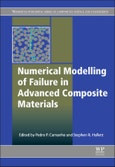Part One investigates numerical modeling approaches to interlaminar failure in advanced composite materials. Part Two considers numerical modelling approaches to intralaminar failure. Part Three presents new and emerging advanced numerical algorithms for modeling and simulation of failure.
Part Four closes by examining the various engineering and scientific applications of numerical modeling for analysis of failure in advanced composite materials, such as prediction of impact damage, failure in textile composites, and fracture behavior in through-thickness reinforced laminates.
Please Note: This is an On Demand product, delivery may take up to 11 working days after payment has been received.
Table of Contents
Part One: Numerical modelling approaches to interlaminar failure in advanced composite materials 1 The virtual crack closure technique for modelling interlaminar failure and delamination in advanced composite materials 2 Modelling delamination with cohesive interface elements 3 Interface elements for fatigue-driven delaminations in advanced composite materials 4 A level set model for delamination in advanced composite materialsPart Two: Numerical modelling approaches to intralaminar failure in advanced composite materials 5 Three-dimensional invariant-based failure criteria for transversely isotropic fibre-reinforced composites 6 An overview of continuum damage models used to simulate intra-laminar failure mechanisms in advanced composite materials 7 Numerical modelling of matrix cracking and intralaminar failure in advanced composite materials 8 Fibre failure modelling
Part Three: Advanced numerical algorithms for modelling and simulation of failure in advanced composite materials 9 Mesh independent matrix cracking and delamination modelling in advanced composite materials 10 A new augmented finite element method (A-FEM) for analysis of failure in advanced composite materials 11 Isogeometric modelling 12 Peridynamics for analysis of failure in advanced composite materials 13 Multiscale modeling of the response and life prediction of composite materials
Part Four: Engineering and scientific applications of numerical modelling for analysis of failure in advanced composite materials 14 Micro-mechanical failure analysis of advanced composite materials 15 Computational micromechanics strategies for the analysis of failure in unidirectional composites 16 Numerical modelling for predicting failure in textile composites 17 Multi-scale modelling for predicting fracture behaviour in through-thickness reinforced laminates 18 Numerical modelling of impact and damage tolerance in aerospace composite structures 19 Strength prediction methods for composite structures: ensuring aeronautical design office requirements








